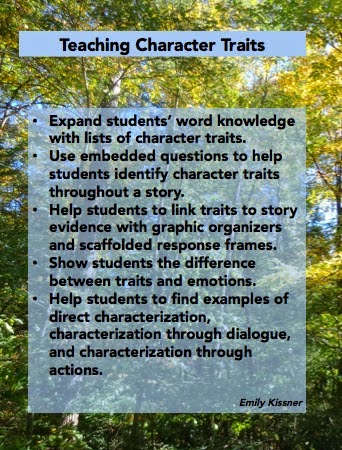Right now I am deep into character traits in my classroom. And it is so delightful! I just love talking to students about characters and how we know what they are like. Discussions of character actions and dialogue and the traits they reveal are so enriching for our class.
Each year I enter into these discussions in slightly different ways. However, some principles guide my lesson planning each year. Here is an overview of my thinking as I embark on a character traits unit.
Expand students' word knowledge with lists of character traits
Many of the words that we use to describe character traits are not common in everyday conversation. Rich, descriptive words like ruthless, impulsive, considerate, and stingy are new for many students. I like to use word lists that group words by common characteristics so that students can learn words efficiently. (A list of character traits is available in Character Traits and Emotions or here.)
Use embedded questions to help students identify character traits throughout a story
I love embedded questions! I remember days of standing by the copier, patiently cutting apart a story so that I could add questions throughout the text. Digital tools make the process much, much easier.
Embedded questions aren't about assessing students, but about guiding students toward making inferences. Transitional readers especially often think of reading a page of text as a monumental effort to be completed as quickly as possible. Embedding questions helps to break up the text and show readers what kinds of inferences they should make at which parts of the story. "Thomas and the Teapot", in Character Traits and Emotions, is an example of a text with embedded questions. However, you can use any text for this strategy.
Help students to link traits to story evidence with graphic organizers and scaffolded response frames
Support, support, support! This is my refrain as we talk about character traits. "What in the story makes you think that?" or "How did you come to think of this trait?"
Graphic organizers help students to collect character traits and text evidence as they go. Scaffolded response frames help students who are still learning the structure of formal academic responses. You can read more about response frames in this blog post.
Show students the difference between traits and emotions
Oh, I hate to see when well-intentioned people muddy the waters between traits and emotions! Traits usually don't change over the course of a story. When they do, the change is usually the main point of a story. Emotions, on the other hand, change frequently based on the events in the story.
Can students understand the difference? They most certainly can, and even readers who struggle can learn to distinguish between traits and emotions. (You can find lots more on character emotions in my book, The Forest AND the Trees, and in lots of other blog posts.)
Help students find examples of direct characterization, characterization through dialogue, and characterization through actions
This is where things get really interesting--as we move beyond just asking, "What are the character's traits?" and into "How does the author let us know about these traits?" For example, this week we started reading There's A Boy in the Girl's Bathroom as a read aloud. I love this book for characterization. In the first three chapters we find out a great deal about Bradley, from each one of these methods. (This book also does show us some examples of trait change, but it certainly doesn't happen in the first three chapters--Bradley's changes over time are part of the main storyline.)
Teaching character traits, just like teaching theme, helps students to see those parts of literature that make us more human. And the language of the traits becomes the language of our classroom. "That was foolhardy of the cricket, to try to escape," one student mused thoughtfully. I was watching the chaos of the escaped cricket (I finally had to stoop down and catch it myself, and I did teach for the next five minutes with a squirming cricket enclosed tightly in my hand) and I thought, "Wow! She used a character trait word!"
Other notes from the week
-A slug escaped, and was nowhere to be found. How could a slug hide in the classroom? We are completely mystified. Just as a side note, the weight of the slug was 31 grams...we found this out shortly before he escaped.
-I am working on third grade homework sets. Their formatting is simpler than the 4/5 homework sets, and I'd love to have someone else look over them. There are currently 3 available with the fourth coming shortly.
-Character traits materials are available on Frolyc.com! If you have student iPads, these are a great way to build character trait knowledge.
-I'm adding some new materials to stories, but I probably won't have time to upload new sets this week. If you are teaching "Hans, the Princess, and the Golden Goose" from Teaching About Theme or "Painting Day" from Summarizing Stories, drop me a line at elkissn@yahoo.com and I'll send you some of the new materials.


No comments:
Post a Comment